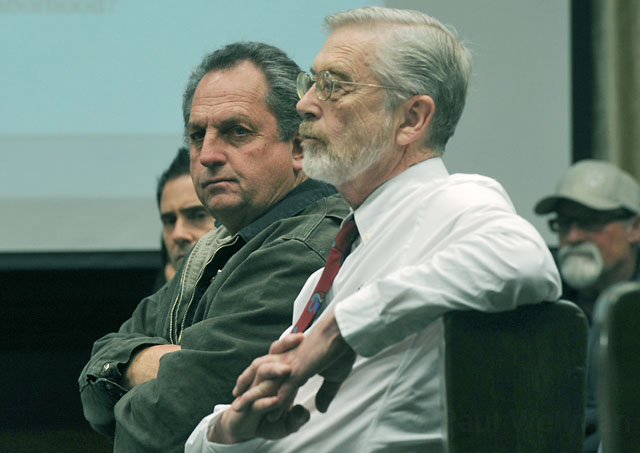Pini-Proofing Chino Street
Neighbors Win Appeal Against Notorious Landlord

Landlord Dario Pini’s bigger-than-life reputation as a serial offender when it comes to Santa Barbara’s health and safety codes clearly preceded him into the City Council chambers Tuesday night. This proved his undoing in a showdown with impressively well-organized Westside residents opposed to his plans to transform an old Chino Street bungalow into a two-structured, two-story rental property.
The neighborhood activists, who live near Pini’s property at 1911 Chino Street, not only secured a unanimous vote by the City Council to send Pini’s proposal back to the Architectural Board of Review to essentially start from scratch, but they unearthed obscure city codes — passed 10 years ago — that gave City Hall powerful discretionary authority to reject Pini’s plans based on his history as a repeat building-code violator. Not even City Attorney Steve Wiley — Pini’s avowed arch-nemesis — understood how much latitude these codes gave City Hall, nor did city planners or members of the council. Going into the meeting, it was unclear what legal justification, if any, could be cited to reject Pini’s proposal. Going out of the meeting, it was equally unclear if Pini will ever build anything on the site. That’s because before he can secure any permits, he must first resolve a massive number of building-code violation claims involving 30 other rental properties he owns throughout the city, now the subject of a major lawsuit between Pini and City Hall.
On the table were plans to build a new two-story apartment and garage in the backyard of 1911 Chino Street. When complete, the property would boast six bedrooms and five bathrooms. Neighbors, led by Evelyn Lee, objected that the structure would intrude into the privacy of their backyards, block mountain views, and create a parking nightmare. They pointed out Pini’s propensity to pack his properties with as many people as possible, and suggested that the roof deck Pini proposed to build on top of the new garage would become party central for reveling renters. Patrick Burns noted that court records contain 713 legal actions involving Pini. “Fool me 713 times and shame on you,” he said. “Fool me 714 times, shame on all of us.” They complained that since Pini bought the property in 2011, he’d used it as a staging ground for his many construction crews. Two 55-gallon drums of contaminated waste stood in the front yard, they complained, and the two-bedroom house in the front was advertised on Craigslist as a four-bedroom home, renting for $3,300 a month. All this, they argued, made Pini’s plans incompatible with the existing neighborhood.
Pini’s architect Gil Barry countered that Pini has developed more workforce rental property than anyone on the South Coast, even the Housing Authority. He disputed Pini’s reputation as a slumlord, arguing that he has developed some of the “most beautiful” properties on the South Coast. Pini sought no modifications or special exemptions for the Chino Street project, he argued, and went above and beyond the changes initially sought by the Architectural Board of Review in order to appease the neighbors. The review board, Barry reminded the council, described Pini’s responsiveness as “exemplary,” before voting 4-3 to approve it. And city planners backed Barry up. Pini acknowledged he had his difficulties with zoning enforcement but credited Wiley for getting him on the right track. In response to the lawsuit filed by Wiley last year, Pini said he got into full compliance within eight days. As for the Craigslist ad, he said that was a typo; the four-bedroom unit he sought to rent was actually on the Eastside. When pressed by Mayor Helene Schneider, he admitted that some students had converted a den and a living room into bedrooms, but he insisted that they did so without his consent and that he evicted them. As for all the lawsuits, he said the vast majority involved evictions.
If Pini looked for any love from Wiley, he was looking in all the wrong places. “There’s no question that Mr. Pini is the definition of scofflaw in Santa Barbara,” Wiley told the council. Councilmember Bendy White expressed grave concerns about Pini’s past, but he was equally troubled that the proposed blueprints appeared to be designed to maximize abuse. Pini’s proposed design, he said, asked the question, “If you were a slumlord, how would you chop it up?” The number of bathrooms coupled with multiple French doors serving as windows, he argued, could be used to further subdivide the property into even more living quarters.
Many councilmembers worried whether it was legally permissible to withhold approval for Pini’s Chino Street project based on past violations. But Westside resident Burns dredged up the city code language empowering city officials to refuse to process plans from applicants with unresolved violations. Wiley argued that because there were no outstanding violations at 1911 Chino Street, the language did not apply. Burns disagreed. When Mayor Helene Schneider read the language out loud, it was evident it gave City Hall sufficient authority to link all Pini’s outstanding zoning violations with the Chino Street approval. Councilmembers gave clear instructions that the new plans be designed with a keen eye to prevent future slumlordification; the garage deck had to go, as did at least one upstairs bathroom, as did as many square feet as Pini and Barry could trim.



